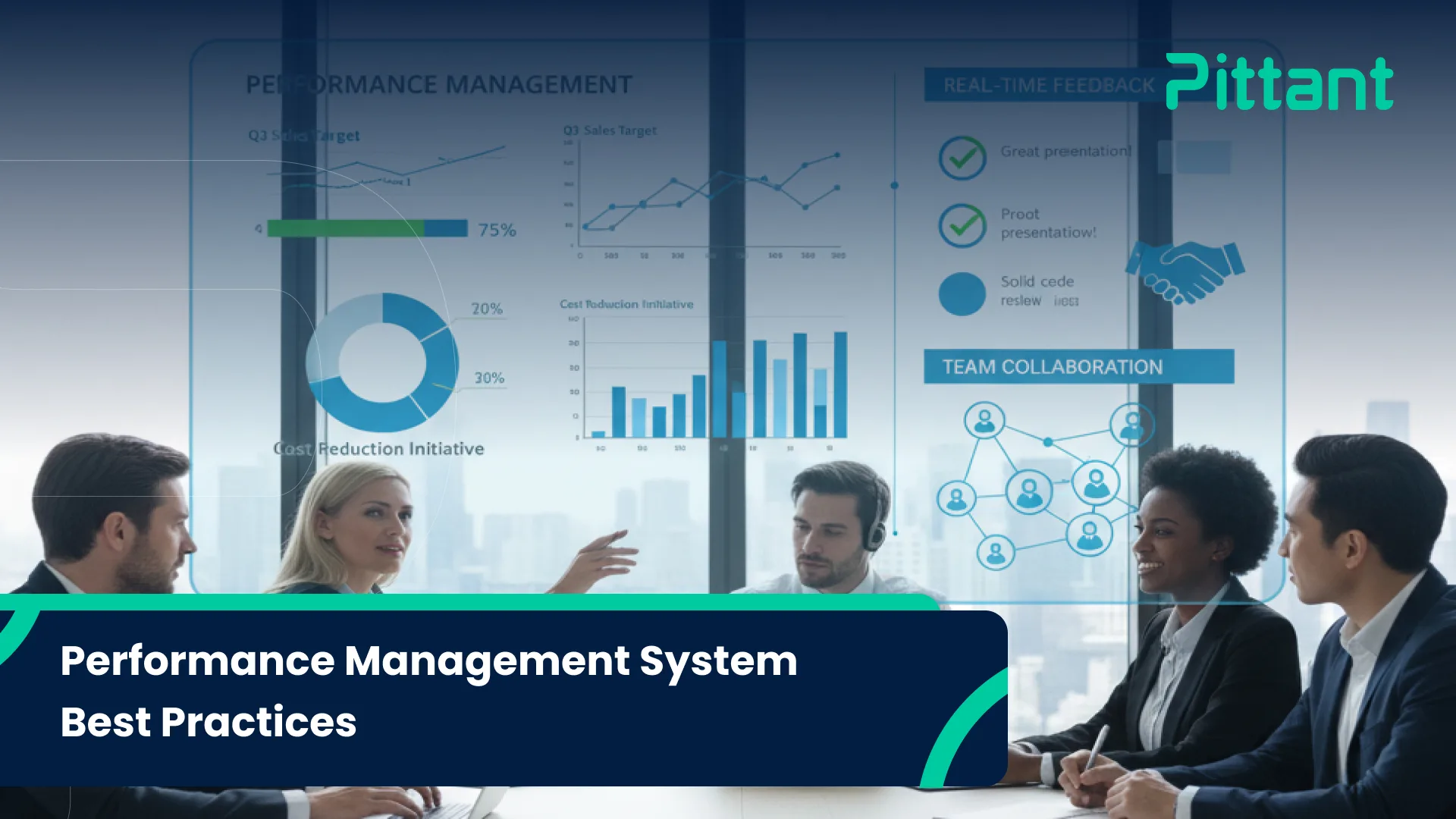Today, companies invest heavily in performance management systems. They do so in the hope of unlocking higher productivity and happier teams. But here’s the catch: Many never see the results they want. Why? Because they overlook the best practices. The approach that makes these systems truly work. Without the right approach, the platform turns into another HR tool.
This blog is your practical guide on performance management system best practices. These practices drive measurable results. We’ll let you learn how to set clear goals and train managers. Along the way, we’ll share actionable tips and blunders to avoid. Lastly, explore with us the role of technology in making everything seamless.
Define Performance Management System:
A structured approach that helps organizations link employee performance to the entire business goals is called a performance management system. It is the bridge between what employees do daily and where the company wants to go.
The system covers goal setting and regular feedback. It also includes evaluations and development planning. It makes employees feel valued and motivated to deliver their best.
There’s a difference between the performance management system and the performance management process. The system refers to the tools and framework. In comparison, the process is the ongoing cycle of setting expectations and monitoring progress. It is also used to recognize results. Both build a high-performing culture that benefits everyone.
Why Following Best Practices Matters:
Performance management platform installation won’t solve performance challenges. Organizations risk ending up with confusing metrics without clear guidelines. It also results in inconsistent reviews or disengaged employees.
That’s where best practices in performance management system come in. They bridge the gap between owning the tool and getting results. The system becomes a driver of growth instead of a compliance checklist by following proven strategies.
Best practices create structure and provide clarity. It greatly helps managers use the system effectively. Guaranteeing workers know what’s expected and feel supported in their development. If you skip them, you risk wasting your investment and frustrating your teams.
Top Performance Management System Best Practices:
In this section, we’ll discuss the best performance management system practices in detail.
Define Goals and Expectations:
Clarity is one of the biggest drivers of success. Workers perform better when they know what’s expected of them. Therefore, setting SMART goals helps define what success looks like.
For example:
Instead of improving sales, a SMART goal would be to increase monthly sales revenue by 15 percent within the next quarter. The approach gives employees a target to aim for. Managers have a benchmark to measure progress. In short, clear goals align individual efforts with business priorities and eliminate confusion.
Train Managers and Employees:
The best system fails if people don’t know how to use it. Training is key! It unlocks all performance management system features.
Managers should learn how to set goals. They also know how to give constructive feedback and use analytics. Workers should understand how to track progress and request support. Organizations risk underutilizing the platform without training. This turns it into an administrative burden.
Onboarding sessions and simple guides ensure everyone uses the system confidently. Training enables the system to transform from another HR tool into an everyday resource that drives growth.
Boost a Culture of Regular Feedback:
Note that reviews alone are no longer enough. Workers want regular check-ins and real-time feedback. Because of this, one of the best tips for performance management systems is building a culture of continuous communication.
Moreover, feedback doesn’t need to be lengthy. But it can be a quick acknowledgment after a project or a conversation during a weekly catch-up. Regular feedback helps employees improve faster. They stay motivated and feel recognized.
Performance conversations shift from being dreaded yearly meetings to ongoing growth discussions when managers embrace this practice. Employees value this practice.
Align System with Strategy:
A performance management system should never operate in isolation. It must connect directly to the company’s vision and goals to drive results. This is where performance management strategies come into play.
The system should track response times and service quality if a business aims to improve customer satisfaction. This links individual goals to organizational priorities. Guaranteeing every employee’s work contributes to the bigger picture.
In short, aligning the system with strategy keeps teams moving in the same direction. It makes performance tracking meaningful.
Integrate Performance Appraisals:
Appraisals are a mandatory piece of the puzzle. They shouldn’t feel disconnected from daily work. A strong system is one that integrates employee performance appraisal into regular workflows.
Instead of one big annual review, companies can schedule quarterly evaluations. This should be tied to the goals. Plus, feedback is already tracked in the system. Resulting reviews become more accurate and timely.
Appraisals stop being stressful events and instead become valuable checkpoints for growth and recognition when they flow into the system.
Mistakes to Skip in Performance Management Systems
Sometimes, organizations make mistakes while implementing a performance management system. Even with the right intentions. The most common ones to avoid are as follows:
Overcomplicating with too many metrics:
Measuring everything confuses employees. That’s why focus only on what truly impacts performance.
Using it as a compliance tool:
Workers won’t take it seriously if the system is only used for ticking boxes.
Not reviewing and updating processes:
Business needs to evolve from time to time. It quickly becomes outdated if the system doesn’t adapt.
Avoid these pitfalls to keep the system simple and growth-focused.
How the Right Software Supports Best Practices
Technology plays a huge role. Specifically, in making performance management effective. The right performance management software brings best practices to life. They come with automation, analytics, and user-friendly dashboards.
Some of the key benefits include:
- Automated goal setting and progress tracking
- Real-time feedback tools
- Customizable performance reviews
- For managers, data-driven insights
- Worker development plans with clear milestones
Organizations save time with the right software. They reduce bias and make performance conversations more data-informed. In short, it helps managers focus less on admin work and more on coaching their teams.
Create a Performance Management Guide for Your Business
Best practices stick when organizations document and standardize them. Creating a performance management guide ensures consistency across all teams.
This guide should outline:
- How to set SMART goals
- The frequency of feedback and reviews
- The process for appraisals
- How managers and employees should use the system
Performance management becomes transparent and sustainable when everyone follows the same playbook
Conclusion
The right performance management system best practices are essential. It transforms the way organizations engage their people. It guarantees employees understand expectations. They receive regular feedback and are aligned with company goals.
The system becomes more than a tool when paired with productive strategies and the right software. It also becomes a driver of engagement, fueling long-term growth.
Invest in best practices today. Take help from Piitant, who offers you a helping hand in understanding the system practices well. With us, watch your performance management efforts deliver real results tomorrow!
FAQs
What are the best practices in performance management systems?
The best practices in performance management systems include:
- Setting SMART goals
- Training managers
- Fostering continuous feedback
- Aligning the system with strategy, and
- Integrating appraisals into everyday workflows.
How can performance management strategies improve employee engagement?
Workers feel valued with strategies like recognition and feedback. Engagement and motivation naturally rise when work ties directly to company goals.
What role does feedback play in performance management?
In performance management, feedback fuels growth. Regular feedback helps employees improve quickly. They stay more motivated and feel supported. This turns performance conversations into opportunities for development.
How do performance management systems differ from employee appraisals?
Employee appraisals are part of the process. However, systems are broader. A performance management system tracks goals, feedback, and progress. In comparison, appraisals are specific evaluation checkpoints.



